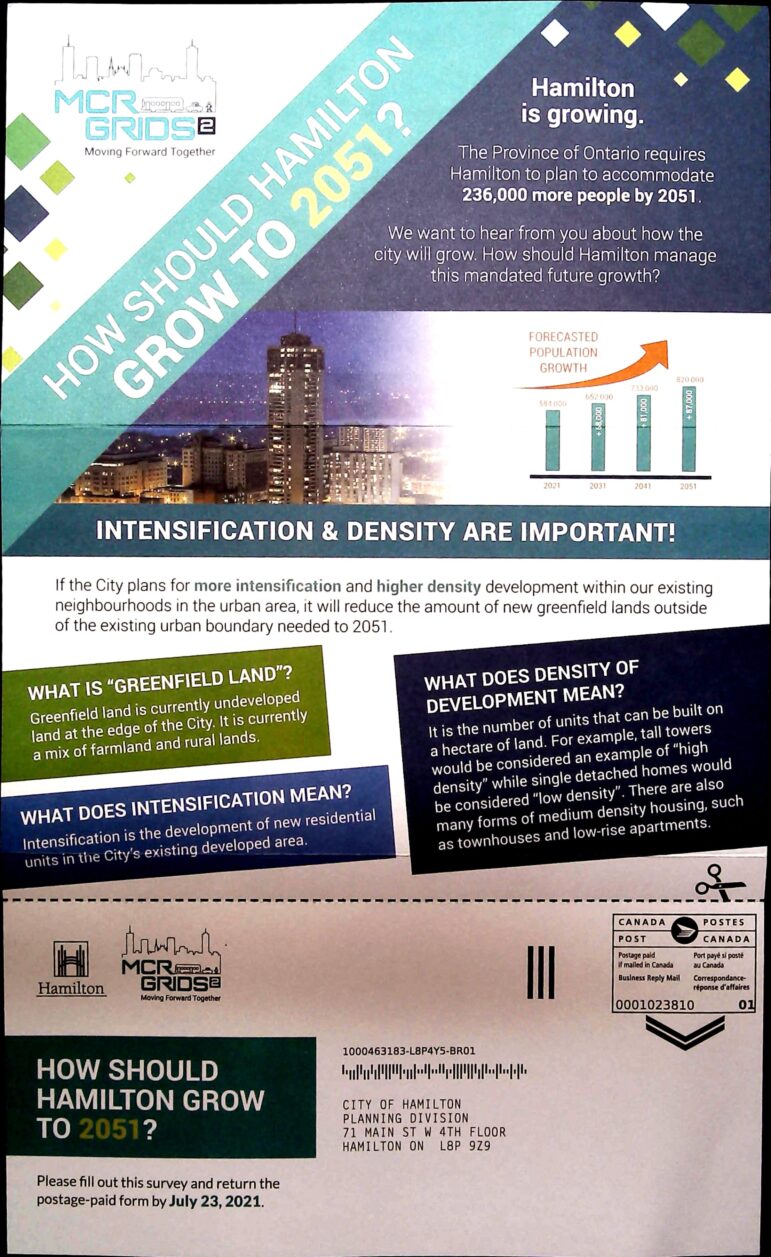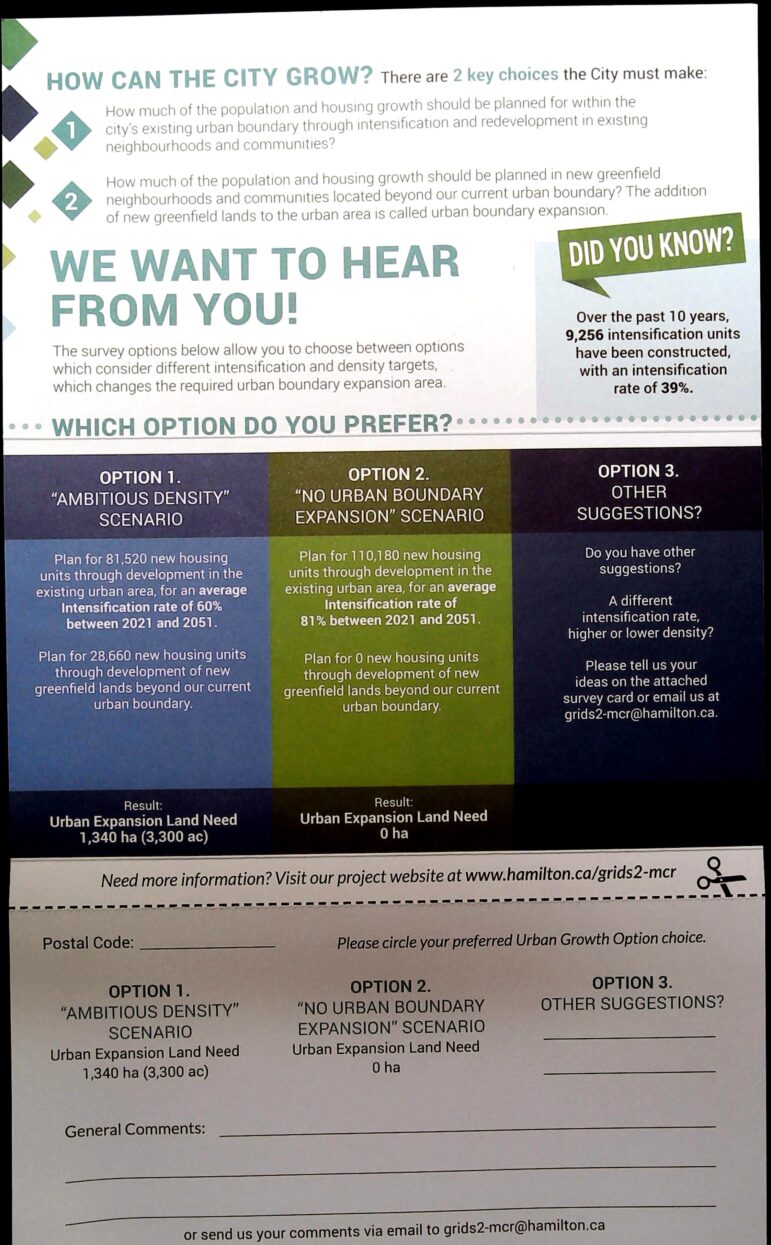Ward 12 Councillor Lloyd Ferguson attacks citizen survey in a pre-emptive strike against freezing urban boundary
Hamiltonians received a survey this week in their mailboxes asking them to choose between expanding the urban boundary onto greenfield lands or freezing the urban boundary. [PDF scan of the survey]
The one-page front-and-back returned postage flyer drew the ire of Ward 12 Councillor Lloyd Ferguson who claims the survey is, as he put it, “I’m trying to find the right word, it’s probably going to be slanted a certain way because of the way it was asked. It’s like the Quebec referendum to support resolution numbers such as such, and without having an explanation of what it means”.
“When I read it [the survey], oh my goodness, this thing is going to be overwhelmingly in favour of intensification, which will be very sensitive to my community”, Ferguson says.
Ferguson is in favour of expanding the urban boundary and absented himself from the vote to engage the public by survey. The March vote to send the survey was unanimous with Ward 5 Councillor Chad Collins also absent.
The survey’s question is not leading or vague – unlike the Quebec referendum question.
It is overtly neutral asking “Which Option Do You Prefer” with three choices:
Option 1: “Ambitious Density” Scenario
Option 2: “No Urban Boundary Expansion” Scenario
Option 3: Other Suggestions – inviting people to submit their own ideas.
The flyer contains no leading information, actually, it may be flawed in not providing information to inform residents about the options presented.
On the front, it simply states “Hamilton is growing. The Province of Ontario requires Hamilton to plan to accommodate 236,000 more people by 2051” [emphasis in the survey] with basic definitions.
Below is the statement “if the City plans for more intensification and higher density development within our existing neighbourhoods in the urban area, it will reduce the amount of new greenfield lands outside of the existing boundary needed to 2051”.
On the back, it states “There are 2 key choices the City must make: <1> How much of the population and housing growth should be planned for within the city’s existing urban boundary through intensification and redevelopment in existing neighbourhoods and communities? <2> How much of the population and housing growth should be planned in new greenfield neighbourhoods and communities located beyond our current urban boundary? The addition of new greenfield lands to the urban area is called urban boundary expansion”.
People Love the Greenbelt, and Love Greenfields
Councillor Ferguson’s complaints are based on his desire to see greenfield development.
As Hamilton Conservation Authority Chair, he most recently pushed for the paving of a wetland. The Conservative Authority Board voted against paving the wetland, following an outpouring of community opposition.
Ferguson knows the public overwhelmingly supports the Greenbelt, as Ontario Premier Doug Ford has repeatedly learned each time he muses about encroaching upon or modifying the boundaries to allow developers to build within the existing protected area.
Greenfield is synonymous to the Greenbelt for most people.
Thus, the root of Ferguson’s complaint – he knows the public will overwhelmingly oppose building on greenfield lands.
It is understandable that City of Hamilton planning staff kept the survey simple and did not present arguments for or against the options.
Ferguson’s developer allies have not put forth a concerted campaign to argue what they see as the merits to the “Ambitious Density” plan to push Hamilton’s urban boundary to include nearly all Hamilton’s remaining greenfield lands not already in the Greenbelt.
Nor has anyone (including myself) put together a good site with arguments for and against the two options. In this regard, we have fallen short of ensuring that we fulfill the deliberative part of our democracy.
I will note The Hamilton Spectator ran good op-ed pieces in late March regarding the proposals and presenting those side-by-side is a good option for those seeking to deliberate.
The Survey, Hamiltonians as represented by it, versus Doug Ford
Ultimately, the survey’s primary purpose is to challenge Ontario Minister of Municipal Affairs Steve Clark’s declaration that if Hamilton City Council refuses to expand the urban boundary, he and local MPP Donna Skelly will expand the boundary by provincial order.
With thousands, potentially tens of thousands, of Hamiltonians having stated they do not want a boundary expansion (and tactility engaged in democracy), the Tories will face a risky political cost in overriding public opinion to pave over greenfield.
Ferguson is foreshadowing the challenges which will follow a boundary freeze – while people may say they want intensification, they often want new development elsewhere in the city.




I would ask people to Google Hamilton population growth. You will find census figures that show virtually stagnant growth in the old city and on average only four thousand increase per year which begs the question who came up with 231,000 over the next 30 years? The figures are census #s since 2001. Secondly what is the impact of dramatic growth legislation when there inevitably will be a change government?
Doug,
Agreed that Hamilton has not seen the growth from intensification which is needed in the lower city. We actually have many triplexes being converted back to single family occupancy.
A note that census counts do not include post-secondary students. We are experiencing significant growth in international students.
The growth is expected due to “push out” from Toronto, and the expectation that the health sector will grow in Hamilton. [To a certain extent, I ponder if Toronto is too strong a pull, especially with the University of Toronto’s massive expansion in spaces available for bio-tech companies to rent]
As for changing governments, here in lies a huge problem – we face long-term challenges but are governed by politic parties that do not look beyond the next election. The new 2051 “growth plan” is an example of short-term thinking, the goal being to please developers in exchange for donations to fund the next PC Party election campaign.
I actually found the wording of the 1st option a bit leading. Some might choose that option just because of the word ambitious. One could argue it would have made more sense to simply state, option 1 Urban Expansion and option 2 No Urban Expansion. Both bland but neither leading.
Yes, the marketing phrase “ambitious density” is a misnomer.